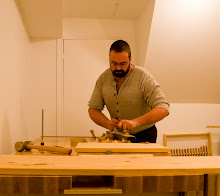
To the left we see the plane till. From left to right, top to bottom, we have a Veritas Bevel-Up Jointer, which I use as a try plane, not a jointer, and old Stanley #6 which I use as a fore plane, a Veritas Low-Angle Jack plane, which I use as a fitting plane, not as a levelling plane. Next comes the Veritas Bevel-Up Smoother, the Veritas Scrub Plane, a Veritas Low-Angle Block Plane with the extra tote and knob to turn it into a "#3 Smoother", Veritas winding sticks, a Stanley G12 low-angle block plane that I bought, perhaps, 15 years ago, and a Veritas low-angle block plane which normally always has a Veritas Chamfer Guide on it. On the shelf below we have a Veritas Router Plane with all of the trimmings, a Veritas Small Router Plane, a Veritas Jointer Fence for the Low-Angle Jack, a Veritas Small Plow Plane plus the blades, a Stanley #78 Duplex Fillister plane, and a Veritas Small Shoulder Plane.
Attached to the side is the piece of 2x4 that I use as an index for my augers, and that stick hanging on the tie peg is just a piece with different sized holes in it (all bored by my auger bits) which helps me figure out what size hole I need for various applications.

2 comments:
Nice till (and herd of planes). How deep did you finally make it?
With the rebuild it ended up 12" deep, leaving the face at a 30 degree angle. The actual angle of the planes is a hair less than that because there are small softwood 'battens' about 1/8" thick near the toe of each plane so that the sole of the plane doesn't rest directly against the wood. I found that this aided in evaporation of condensation, etc.
Post a Comment